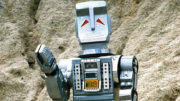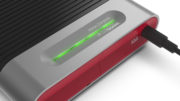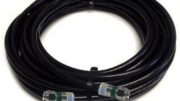This article started out as a discussion between me and one of the tech experts at Solid Signal. That’s the nice thing about working at Solid Signal really. We have a lot of great discussions that end up really benefiting the customer. In this case, it involved a theoretical install where the indoor antenna needed to be 150 feet from the booster.
A little about loss over distance
Anytime a signal travels through a cable, there is going to be some loss. You can think of it sort of like friction. If you roll a ball across a flat surface, it doesn’t go forever. It eventually stops, because it encounters friction on the surface and overcoming that friction takes energy. Believe it or not signal through a wire is the same thing. Pushing those electrons through a wire rids them of some energy. Not much, but some. Eventually, there’s not enough signal to overcome the noise inherent in the line.
Every different type of cable has a different loss characteristic. RG11 has less loss than RG6, for example. In the case of commercial cell boosters, we recommend Wilson400 low loss cable. It meets or exceeds the LMR400 standard for 50-ohm cables and was designed by Wilson Electronics specifically for the needs of cell phone signal boosters.
One more thing before we get to the meat and potatoes of this article. Not only is every type of cable different, but there’s a different loss characteristic for each frequency. Higher frequencies lose energy faster than lower ones, due to the energy it takes to create such closely spaced waves. So whenever you consider the loss characteristic of a cable, you have to consider what frequencies are going through it. In the case of cell phone signal boosters, you have to consider 600-2150MHz. Generally, we look at the loss inherent in the highest frequency, because that’s going to be the worst case scenario.
And now the answer you’ve been waiting for
Wilson400 cable loses 7dB per 100 feet at 2150MHz. Compare this, for example, to RG6 which loses 9.5dB per 100 feet at the same frequency. 2.5dB may not seem like much, but it can be the difference between success and failure.
Now the question of how long the cable can be comes down to the antennas you use, and the performance you expect. Wilson’s commercial antennas tend to have about 8dB gain, sometimes more. If you’re running 110 feet of cable, you’ve completely negated the gain of the antenna and you’re simply working with the amount of signal that a cell phone could get on its own. That’s still “something,” which is better than nothing if you’re in a building where there’s no service indoors. But obviously you would like to do better than that with a booster system. That’s why we talk about typical runs of 25-50 feet with boosters. Any more than that and we often suggest multiple boosters or special solutions.
Special solutions?

Yes, for example in a larger install we recommend something like the WilsonPRO 4300. This looks like one booster but is actually four separate boosters in one chassis. It has improved broadcast power and super-sensitive antennas. This allows you to run four cables from the base of 100 feet each. This in turn lets you boost an area of up to 100,000 square feet with reasonable success.

For smaller areas, you can use a booster like the WilsonPRO 1050. This booster lets you run a single cable much longer than normal because of its inline amplifier. This is the only system with an approved bidirectional amplifier and it lets you boost areas up to 35,000 square feet.
Need help with a custom design?
I know that for some people, cell phone signal booster installation is super easy. But, if you’re not one of those people, why not bring in the experts? Call our Signal Connect Division. We have trained and certified techs who can plan a custom system for you no matter what size space you need to cover. We have the tools, the talent, and the time to work with you to get you what you need. Call the experts at 888-233-7563 during East Coast business hours. You’ll discover the meaning of “white glove service.” If it’s after business hours, fill out the form below and we’ll get back to you, usually within one business day.





